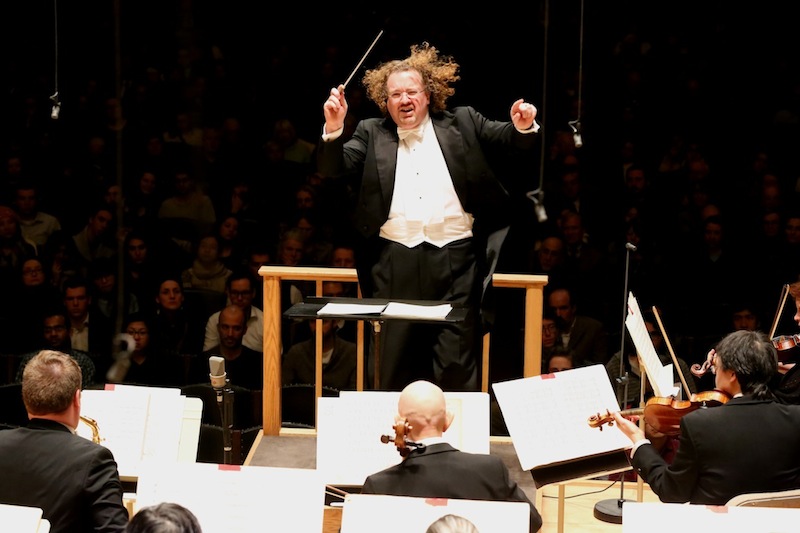Shovels down! Denève, BSO bring much-needed fun à la 1920s’ Paris
Snow-weary Bostonians could hardly have asked for a fizzier midwinter tonic than Thursday night’s Boston Symphony Orchestra program conducted by Stéphane Denève.
Attending this concert was like receiving a valentine postmarked “Paris, 1923.” Three of the four tuneful, charming pieces on the program had premiered in that city in that year. And the fourth, Stravinsky’s Pulcinella, composed for Paris in 1920, was a piece that showed the way for the other three.
Those were weary times, too—not of snow, but of war. In concert halls and theaters, the yearning for music that celebrated orderliness and pleasure was almost palpable. Stravinsky, who had caused a riot in 1913 with his groundbreaking (in more ways than one) ballet The Rite of Spring, now fell in love with some graceful Baroque tunes and fashioned a ballet from them, ushering in his own “neoclassical” period and helping establish the blithe spirit of the postwar years.
Sergei Prokofiev, notorious as music’s dish-breaking bad boy, was having a similar change of heart. His Violin Concerto No. 1—played magnificently Thursday night by soloist James Ehnes and the BSO —may not have borrowed actual 18th-century vocabulary like his Symphony No. 1 (”Classical”), but its air of composure and shapely melodies were very much in the new spirit.
And two young Frenchmen, Darius Milhaud and Francis Poulenc, didn’t need converting—they seemed born to write music that brought a smile. Peppy ballet scores by each—Milhaud’s La Création du monde and Poulenc’s Suite from Les Biches—had listeners grinning Thursday night in Symphony Hall.
Stravinsky’s Pulcinella Suite (in the 1947 orchestration) led off the proceedings sonorously and with outstanding individual performances, including associate concertmasterTamara Smirnova’s many and varied violin solos, and a richly humorous exchange between trombonist Toby Oft and double bassist Edwin Barker in the Vivo movement.
Still, as conducted by Denève with broad gestures, leisurely tempos, and a certain casualness about rhythm, this performance of Stravinsky’s crisp score seemed just a bit slushy, like the sidewalks outside Symphony Hall. Even while acknowledging that this was a modern adaptation and not actual Baroque music, one couldn’t shake the memory of how our local “historically-informed” bands put a rhythmic charge in their antique repertoire.
In Prokofiev’s concerto, however, the clear, elegant playing of violinist Ehnes seemed to put the orchestra on its mettle, as the soloist duetted prettily with individual players in the first movement and meshed as the principal voice in the organ-like orchestral sonorities of the finale. Denève deftly partnered him in weaving the work’s rapt atmosphere.
The presence of Ehnes’s violin tone in the large hall seemed as intimate as chamber music, as he effortlessly projected the finest details of Prokofiev’s fantasy-like score. In the piece’s central scherzo, the violinist dazzled with scorching scales, left-hand pizzicato, slashing martellato, and fast, whistling harmonics, all without losing his impeccable cool.
Ehnes received, and deserved, the biggest ovation of the night. He obliged with an encore, a tastefully swoony rendition of the Largo from Bach’s Sonata for Solo Violin in C major, BWV 1005.
On this evening, Prokofiev’s score had the advantage of being music composed to be listened to without reference to anything else. But who would pass up an opportunity to hear the delicious accompaniments Stravinsky, Milhaud, and Poulenc wrote for dancers? If it was all a bit random and episodic, who cared?
Milhaud’s jazz-colored ballet on “the creation of the world” opened in dusky tones with the haunting sound of an alto saxophone over undulating strings, then swung hot with a most un-Haydn-like “representation of chaos.” As one brightly-colored movement followed another, the vivid individual contributions of the players in the tiny orchestra were too numerous to single out, and behind them artful management of the large percussion array subtly held it all together.
After this piece for small combo, the stage seemed to fill to capacity for Poulenc’s cheeky ballet score, in which the 23-year-old composer often seemed to be paying overt homage to Pulcinella, and maybe even filching a crackling trumpet call or two from it.
The big orchestra stepped lively under Denève’s direction, while having the resources for a room-filling string sound or a rich glow of brass when needed. Mostly, one was aware less of grand orchestral tutti than of the endless felicities of scoring and colorful doublings (oboe with violins, for example) that Denève and the players rendered elegantly.
Each movement had its distinct character, from the silky Adagietto and the tarantella-like Rag-Mazurka to the tuneful Andantino with boisterous brass and horn interruptions and the Final with its flood of striking ideas and effects. Bar by bar, musicians and conductor hugged the corners as they steered through Poulenc’s whims of tempo and coloration, to exhilarating effect.
A more welcome diversion in these times than this program could hardly be imagined. So this weekend at least, if somebody asks you “What do people do for fun around here?”—send them to Symphony Hall.
The program will be repeated 1:30 p.m. Friday and 8 p.m. Saturday. bso.org; 617-266-1200.
Posted in Performances
